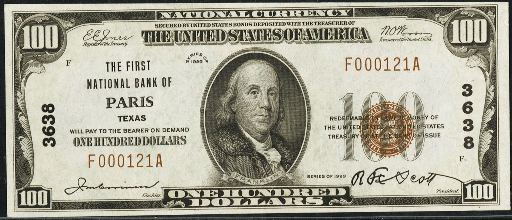The First National Bank Of Canton
The First National Bank Of Canton in Illinois printed $1,235,900 dollars worth of national currency. Over $1,000,000 face value is a lot of money. However, some types and denominations of currency from this bank could still be rare. This national bank opened in 1864 and stopped printing money in 1933, which equals a 70 year printing period. That is considering a long operation period for a national bank. During its life, The First National Bank Of Canton issued 14 different types and denominations of national currency. We have examples of the types listed below. Your bank note should look similar. Just the bank name will be different. For the record, The First National Bank Of Canton was located in Fulton County. It was assigned charter number 415.
We buy all national currency. Please call or email us for a quote. Sales@AntiqueMoney.com
The First National Bank Of Canton in Illinois issued 6,000 sheets of $1 original series national bank notes. Just because a print range is between 5,000 and 10,000 doesn’t mean that individual notes will be easy to buy. That number isn’t really high or low. Some notes are extremely rare and some could be from a hoard. Values are determined based on condition and the number of known survivors. One of the most interesting things about early first charter one dollar national bank notes is all of the different slight variations you can find. Some notes have a red charter number, others do not. Some have red serial numbers and some have blue serial numbers. Some are printed on white paper and others are printed on paper with a slight blue tint. You can really find lots of different ways to collect these. Generally speaking, prices for “first charter aces” are down from their highs. So there are some bargains in this arena of collecting.
Original Series $1 National Bank Note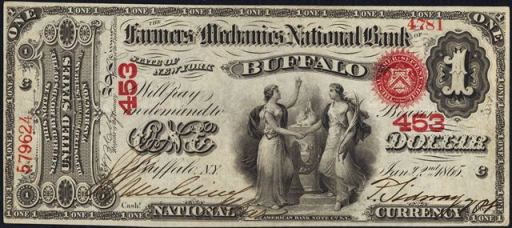
The First National Bank Of Canton printed 6,000 sheets of $2 original series national bank notes. It is important to know production numbers for original series two dollar bills for informational purposes. All $2 bills printed before 1875 are very rare and highly desirable. Most survivors represent the only known example for that bank. Collectors call these $2 bills lazy deuces. The large two on the face of the bill is pictured horizontally, thus making it look lazy. Don’t be fooled by the silly name though. These can be worth significant amounts of money on many occasions.
Original Series $2 National Bank Note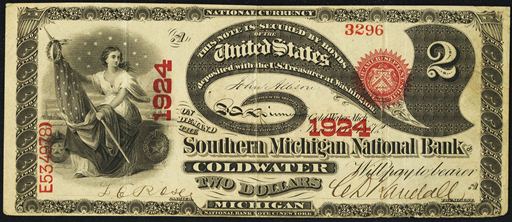
The First National Bank Of Canton also printed 6,075 sheets of $5 original series national bank notes. Just because a print range is between 5,000 and 10,000 doesn’t mean that individual notes will be easy to buy. That number isn’t really high or low. Some notes are extremely rare and some could be from a hoard. Values are determined based on condition and the number of known survivors. Each five dollar original series bank note has a spiked red seal. That is pretty much the only design difference between it and later issues. These are really beautiful notes. One neat thing about these is that the back of each note has a vignette of the corresponding state seal. Some of the state seals are very imaginative. Collecting by state seal was very popular early on in the hobby. Today most collectors are more concerned about bank of issue and condition. Serial number one bank notes are also extremely popular.
Original Series $5 National Bank Note
The First National Bank Of Canton also printed 1,210 sheets of $10 series of 1875 national bank notes. Any time you see a print range between 1,000 and 2,500 you can assume that the bank was small and that their notes could be fairly scarce. The two vignettes seen on 1875 $10 bank notes are “Franklin and Electricity” and “America Seizing Lightning”. These notes occasionally confuse novices because the year 1752 is printed on them. That is when Benjamin Franklin discovered electricity. It has nothing to do with when these bank notes were issued. The back of each $10 bill has “DeSoto Discovering the Mississippi.”
Series of 1875 $10 National Bank Note
The First National Bank Of Canton also printed 1,210 sheets of $20 series of 1875 national bank notes. The exact number of series of 1875 $20 national bank notes printed by this bank is good to know. Don’t expect a high number to lower the value or a small number to increase the value. These notes are scarce enough on their own that the stats don’t really matter. Twenty dollars was a lot of money between 1875 and 1901, which is the time period in which these were printed. These just weren’t saved in high numbers.
Series of 1875 $20 National Bank Note
The First National Bank Of Canton also printed 3,590 sheets of $5 1882 brown back national bank notes. That it is not an exceptionally low number of sheets. However, you have to remember that we are talking about bank notes printed before 1902. Even a large print number could have a very low survival rate. You can take the total number of sheets printed and multiply that number by four to get the exact number of 1882 $5 brown back bank notes this bank issued. Each note has a portrait of James Garfield on the left hand side of the bill. These are very popular with collectors because they have different text layouts. Some notes are worth as little as a few hundred dollars, but most are worth a good deal more.
Series of 1882 $5 Brown Back
The First National Bank Of Canton also printed 255 sheets of $50 1882 brown back national bank notes. Fifty dollar 1882 brown backs are few and far between. When the print number is under 1,000 like this bank then there is a great chance that you have a very rare bank note. The most common 1882 $50 brown backs are worth about $5,000. However, some can be worth more than $10,000 based on condition, serial number, and bank of issue.
Series of 1882 $50 Brown Back
The First National Bank Of Canton also printed 255 sheets of $100 1882 brown back national bank notes. High denomination $50 and $100 brown backs were printed on the same sheet. So the number of sheets printed also equals the number bills printed for each denomination. You can see that $100 brown backs are extremely scarce on this bank. We are very interested in purchasing $100 1882 brown back national bank notes. We have paid more than $15,000 for some examples. Send us pictures of what you have and we will respond quickly with an appraisal and offer.
Series of 1882 $100 Brown Back
The First National Bank Of Canton also printed 1,420 sheets of $50 1902 red seal national bank notes. That is also the exact number of $50 red seals printed by this bank. Each sheet contained one $50 bill and one $100 bill. They are all extremely rare. The value for a generic circulated example is usually around $4,000. Most are worth more and some can be worth considerably more. John Sherman is pictured on each note. Otherwise it has the same markings you would expect to find on any 1902 red seal.
1902 $50 Red Seal National Bank Note
The First National Bank Of Canton also printed 1,420 sheets of $100 1902 red seal national bank notes. As we said above, all high denomination 1902 red seals are extremely rare. The number of notes printed really doesn’t matter to collectors. 1902 $100 red seals are rare to the point that they are always in demand. Of course the standard valuation rules still apply. Condition and bank of issue are of paramount importance. We have paid over $12,000 for some of the rarest specimens.
1902 $100 Red Seal National Bank Note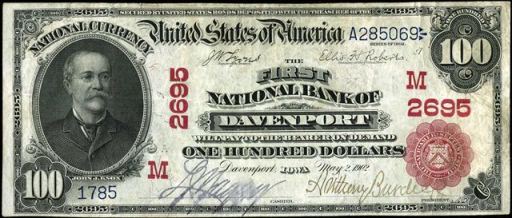
The First National Bank Of Canton also printed 2,039 sheets of $50 1902 blue seal national bank notes. There is no trick to knowing which 1902 blue seals will be common and rare. Often times the number printed won’t tell you much information. The value still comes down to condition and demand. That is a surprise to most people. In fact, most 1902 $50 bills we see are worth between $750 and $1,250. The rarer ones can be worth more than $5,000. However, there isn’t much middle ground.
1902 $50 Blue Seal National Bank Note
The First National Bank Of Canton also printed 2,039 sheets of $100 1902 blue seal national bank notes. It is no coincidence that the sheet numbers for $50 bills and $100 bills are the same. They were printed on the same sheets. Most $100 blue seals are at least scarce; others can be very rare. John J Knox is printed on the front of each bill. Most collectors like the back design a lot more though. It is really unique and different from most other national bank notes. Prices for 1902 $100 blue seals are pretty similar to $50 blue seals. They are both equally common or equally rare, depending on how you look at it.
1902 $100 Blue Seal National Bank Note
The First National Bank Of Canton also printed 237 sheets of Type1 1929 $50 national bank notes. That may sound like a very small number, and it is. However, when it comes to small size notes, that print range usually allows for a handful of survivors. As is the case with all modern fifty dollar bills, Ulysses Grant is pictured on the front of 1929 $50 bills. This is a higher denomination that was only printed by 300 different national banks. Many examples are only worth around a few hundred dollars. Rarer specimens can sell for more than $1,000.
Series of 1929 Type1 $50 National Bank Note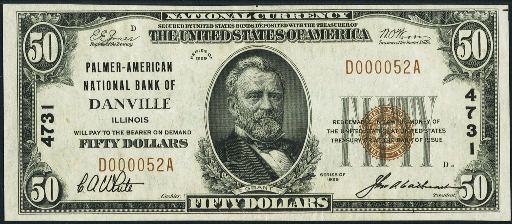
The First National Bank Of Canton also printed 75 sheets of Type1 1929 $100 national bank notes. That is an extremely small sheet printing number. Survivors are still likely but definitely not guaranteed. Despite saying series of 1929, all type1 national bank notes were actually printed between 1929 and 1933. Exactly 289 national banks printed $100 type1 notes. Most are relatively common. However, as with anything, there are always exceptions to that rule.
Series of 1929 Type1 $100 National Bank Note